
Connect 1-Semester Online Access for Principles of General, Organic & Biochemistry
2nd Edition
ISBN: 9780077633707
Author: Janice Smith
Publisher: Mcgraw-hill Higher Education (us)
expand_more
expand_more
format_list_bulleted
Concept explainers
Question
Chapter 5, Problem 5.52UKC
(a)
Interpretation Introduction
Interpretation:
The reaction type as endothermic or exothermic reaction from the graph has to be given.
The given graph is,
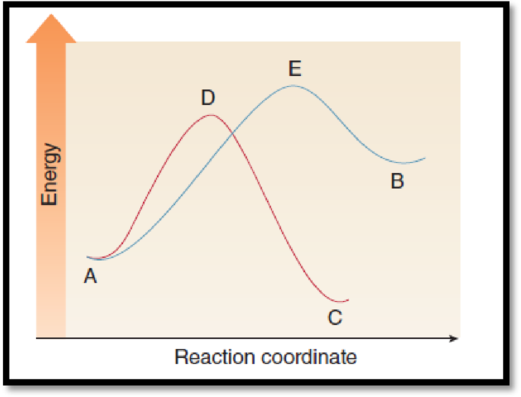
Figure 1
(b)
Interpretation Introduction
Interpretation:
The faster reaction in the graph has to be given.
The given graph is,
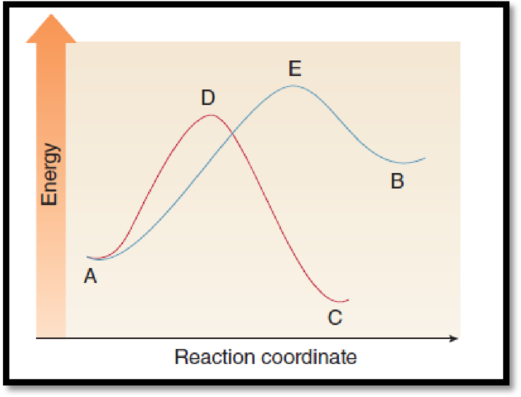
Figure 1
(c)
Interpretation Introduction
Interpretation:
The reaction generates products in lower energy has to be given.
The given graph is,
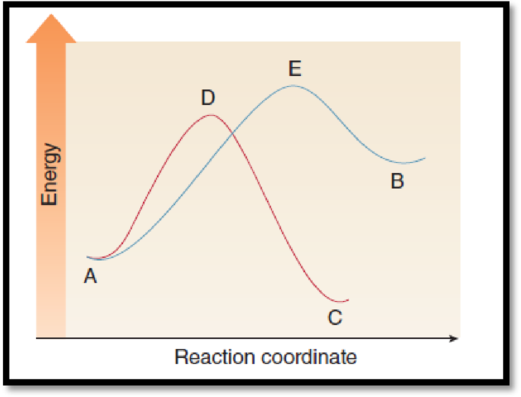
Figure 1
(d)
Interpretation Introduction
Interpretation:
The point on the graph corresponds to the transition state has to be given.
The given graph is,

Figure 1
(e)
Interpretation Introduction
Interpretation:
The point corresponds energy of activation has to be given.
The given graph is,
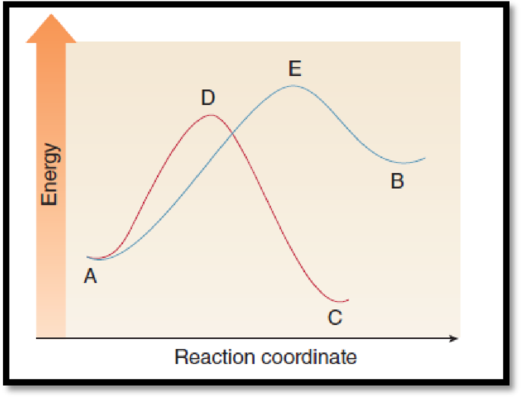
Figure 1
(f)
Interpretation Introduction
Interpretation:
The enthalpy of the reaction has to be given.
The given graph is,
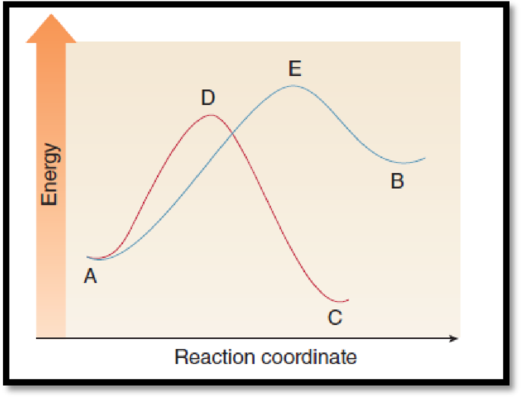
Figure 1
Expert Solution & Answer
Want to see the full answer?
Check out a sample textbook solution
Students have asked these similar questions
Compound A can be converted to either B or C. The energy diagrams for both processes are drawn on the graph below.
a.Label each reaction as endothermic or exothermic.
b. Which reaction is faster?
c. Which reaction generates the product lower in energy?
d.Which points on the graphs correspond to transition states?
e. Label the energy of activation for each reaction.
f. Label the ΔHo for each reaction.
Consider the following energy diagram.
a.How many steps are involved in this reaction?
b. Label ΔHo and Ea for each step, and label ΔHooverall.
c.Label each transition state.
d.Which point on the graph corresponds to a reactive intermediate?
e.Which step is rate-determining?
f. Is the overall reaction endothermic or exothermic?
3. A typical diet in the United States provides 15% of the calories from protein, 45%
from carbohydrates, and the remainder from fats. Calculate the grams of protein,
carbohydrate, and fat to be included each day in diets having the following caloric
requirements.
a. 1200 kcal
b. 1900 kcal
c. 2600 kcal
Chapter 5 Solutions
Connect 1-Semester Online Access for Principles of General, Organic & Biochemistry
Ch. 5.1 - Use the molecular art to identify the process as a...Ch. 5.1 - Use the molecular at to identify the process as a...Ch. 5.1 - Prob. 5.3PCh. 5.1 - Prob. 5.4PCh. 5.1 - Write a chemical equation from the following...Ch. 5.2 - Prob. 5.6PCh. 5.2 - Prob. 5.7PCh. 5.2 - Prob. 5.8PCh. 5.2 - Prob. 5.9PCh. 5.2 - Prob. 5.10P
Ch. 5.3 - Prob. 5.11PCh. 5.3 - Prob. 5.12PCh. 5.3 - How many molecules are contained in each of the...Ch. 5.3 - Prob. 5.14PCh. 5.4 - Prob. 5.15PCh. 5.4 - Prob. 5.16PCh. 5.4 - Prob. 5.18PCh. 5.4 - Prob. 5.19PCh. 5.5 - Use the balanced equation for the reaction of N2...Ch. 5.5 - Prob. 5.21PCh. 5.6 - Using the balanced equation for fermentation...Ch. 5.6 - Prob. 5.23PCh. 5.6 - Prob. 5.24PCh. 5.6 - Prob. 5.25PCh. 5.7 - Prob. 5.26PCh. 5.7 - Prob. 5.27PCh. 5.7 - Prob. 5.28PCh. 5.7 - Early pacemakers generated an electrical impulse...Ch. 5.8 - Prob. 5.30PCh. 5.8 - Prob. 5.31PCh. 5.8 - Prob. 5.32PCh. 5.8 - Prob. 5.33PCh. 5.9 - Prob. 5.34PCh. 5.9 - Prob. 5.35PCh. 5.9 - Prob. 5.36PCh. 5.10 - Prob. 5.37PCh. 5.10 - In which direction is the equilibrium shifted with...Ch. 5 - Use the molecular art to identify the process as a...Ch. 5 - Prob. 5.40UKCCh. 5 - Prob. 5.41UKCCh. 5 - Prob. 5.42UKCCh. 5 - Prob. 5.43UKCCh. 5 - Prob. 5.44UKCCh. 5 - Prob. 5.45UKCCh. 5 - Spinach, cabbage, and broccoli are excellent...Ch. 5 - Prob. 5.47UKCCh. 5 - Prob. 5.48UKCCh. 5 - Prob. 5.49UKCCh. 5 - Rechargeable nickelcadmium batteries are used in...Ch. 5 - Prob. 5.51UKCCh. 5 - Prob. 5.52UKCCh. 5 - Prob. 5.53UKCCh. 5 - Prob. 5.54UKCCh. 5 - Prob. 5.55APCh. 5 - Prob. 5.56APCh. 5 - Prob. 5.57APCh. 5 - Prob. 5.58APCh. 5 - Prob. 5.59APCh. 5 - Prob. 5.60APCh. 5 - Prob. 5.61APCh. 5 - Prob. 5.62APCh. 5 - Prob. 5.63APCh. 5 - Consider the reaction, 2 NO + 2 CO N2 + 2 CO2....Ch. 5 - Prob. 5.65APCh. 5 - Prob. 5.66APCh. 5 - Prob. 5.67APCh. 5 - Prob. 5.68APCh. 5 - Prob. 5.69APCh. 5 - Prob. 5.70APCh. 5 - Prob. 5.71APCh. 5 - Prob. 5.72APCh. 5 - Prob. 5.73APCh. 5 - Prob. 5.74APCh. 5 - Prob. 5.75APCh. 5 - Prob. 5.76APCh. 5 - Prob. 5.77APCh. 5 - Prob. 5.78APCh. 5 - Prob. 5.79APCh. 5 - Prob. 5.80APCh. 5 - Prob. 5.81APCh. 5 - Prob. 5.82APCh. 5 - Prob. 5.83APCh. 5 - Prob. 5.84APCh. 5 - Prob. 5.85APCh. 5 - Prob. 5.86APCh. 5 - Prob. 5.87APCh. 5 - Prob. 5.88APCh. 5 - Prob. 5.89APCh. 5 - Prob. 5.90APCh. 5 - Prob. 5.91APCh. 5 - Prob. 5.92APCh. 5 - Prob. 5.93APCh. 5 - Prob. 5.94APCh. 5 - Prob. 5.95APCh. 5 - Prob. 5.96APCh. 5 - Prob. 5.97APCh. 5 - Prob. 5.98APCh. 5 - Prob. 5.99APCh. 5 - Prob. 5.100APCh. 5 - Prob. 5.101APCh. 5 - Prob. 5.102APCh. 5 - Prob. 5.103CP
Knowledge Booster
Learn more about
Need a deep-dive on the concept behind this application? Look no further. Learn more about this topic, chemistry and related others by exploring similar questions and additional content below.Similar questions
- 9.75 Explain why each of the following chemical equations is not a correct formation reaction. (a) 4Al(s)+3O2(g)2Al2O3(s) (b) N2(g)+32H2(g)NH3(g) (c) 2Na(s)+O(g)Na2O(s)arrow_forwardxplain why aluminum cans make good storage containers for soft drinks. Styrofoam cups can be used to keep coffee hot and cola cold. How can this be?arrow_forwardExplain why each of the following chemical equations is not a correct formation reaction: 4Al( s )+3 O 2 ( g )2 Al 2 O 3 ( s ) N 2 ( g )+ 3 2 H 2 ( g ) NH 3 ( g ) 2Na( s )+O( g ) Na 2 O( s )arrow_forward
- Draw an energy diagram graph for an endothermic reaction where no catalyst is present. Then draw an energy diagram graph for the same reaction when a catalyst is present. Indicate the similarities and differences between the two diagrams.arrow_forward. Consider the exothermic reaction CO(g)+2H2(g)CH3OH(l)Predict three changes that could be made to the system that would decrease the yield of product over that produced by a system in which no change was made.arrow_forwardHydrogen chloride gas dissolves in water to form hydrochloric acid (an ionic solution). HCl(g)H2OH+(aq)+Cl(aq) Find H for the above reaction. The data are given in Table 6.2.arrow_forward
- Sketch an energy diagram graph representing an exothermic reaction, and label the following. a. Average energy of reactants b. Average energy of products c. Activation energy d. Amount of energy liberated during the reactionarrow_forwardWhich statement correctly describes an endothermic chemical reaction? A. The products have higher potential energy than the reactants, and the ∆H is negative. B. The products have higher potential energy than the reactants, and the ∆H is positive. C. The products have lower potential energy than the reactants, and the ∆H is negative. D. The products have lower potential energy than the reactants, and the ∆H isarrow_forwardConsider the following energy diagram for the conversion of A → G. a.Which points on the graph correspond to transition states? b. Which points on the graph correspond to reactive intermediates? c.How many steps are present in the reaction mechanism? d. Label each step of the mechanism as endothermic or exothermic. e.Label the overall reaction as endothermic or exothermic.arrow_forward
- 6. Consider the following four energy diagrams: A B Potential energy Potential energy Reaction Reaction coordinate coordinate C D Potential energy Potential energy Reaction coordinate Reaction coordinate Which diagrams correspond with a two-step mechanism? Which diagrams correspond with a one-step mechanism? Compare energy diagrams A and C. Which has a relatively larger Ea? Compare diagrams A and C. Which has a negative AG? Compare diagrams A and D. Which has a positive AG? Compare all four energy diagrams. Which one exhibits the largest Ea? Which processes will have a value of Keq that is greater than 1? Which process will have a value of Keq that is roughly equal to 1?arrow_forward4. The rate of a chemical reaction may be defined as a.the time it takes for the reaction to be completed b. the change in concentration of any one of the reactants.only c. the change in concentration of any one of the reactants or products d. the change in concentration of any one of the products only 5. Which one of the following does a catalyst affect in a chemical reaction? a. The amount of heat liberated or absorbed during the reaction. b. The amount of product(s) formed. c. The amount of reactants needed for the reaction to take place. d. The speed of the reaction.arrow_forward2. Reaction I has a AG of 16.2 kJ/mol and Reaction 2 has a AG of -62.1 kJ/mol. Which statement is correct about these two reactions? A. Reaction 1 occurs faster. B. Reaction 2 occurs faster. C. Both reactions occur at the same rate. D. Reaction I will never occur. E. It is impossible to know which reaction occurs faster with this information. Answer:arrow_forward
arrow_back_ios
SEE MORE QUESTIONS
arrow_forward_ios
Recommended textbooks for you
 General, Organic, and Biological ChemistryChemistryISBN:9781285853918Author:H. Stephen StokerPublisher:Cengage Learning
General, Organic, and Biological ChemistryChemistryISBN:9781285853918Author:H. Stephen StokerPublisher:Cengage Learning Chemistry for Today: General, Organic, and Bioche...ChemistryISBN:9781305960060Author:Spencer L. Seager, Michael R. Slabaugh, Maren S. HansenPublisher:Cengage Learning
Chemistry for Today: General, Organic, and Bioche...ChemistryISBN:9781305960060Author:Spencer L. Seager, Michael R. Slabaugh, Maren S. HansenPublisher:Cengage Learning Living By Chemistry: First Edition TextbookChemistryISBN:9781559539418Author:Angelica StacyPublisher:MAC HIGHER
Living By Chemistry: First Edition TextbookChemistryISBN:9781559539418Author:Angelica StacyPublisher:MAC HIGHER Chemistry: The Molecular ScienceChemistryISBN:9781285199047Author:John W. Moore, Conrad L. StanitskiPublisher:Cengage Learning
Chemistry: The Molecular ScienceChemistryISBN:9781285199047Author:John W. Moore, Conrad L. StanitskiPublisher:Cengage Learning General Chemistry - Standalone book (MindTap Cour...ChemistryISBN:9781305580343Author:Steven D. Gammon, Ebbing, Darrell Ebbing, Steven D., Darrell; Gammon, Darrell Ebbing; Steven D. Gammon, Darrell D.; Gammon, Ebbing; Steven D. Gammon; DarrellPublisher:Cengage Learning
General Chemistry - Standalone book (MindTap Cour...ChemistryISBN:9781305580343Author:Steven D. Gammon, Ebbing, Darrell Ebbing, Steven D., Darrell; Gammon, Darrell Ebbing; Steven D. Gammon, Darrell D.; Gammon, Ebbing; Steven D. Gammon; DarrellPublisher:Cengage Learning

General, Organic, and Biological Chemistry
Chemistry
ISBN:9781285853918
Author:H. Stephen Stoker
Publisher:Cengage Learning


Chemistry for Today: General, Organic, and Bioche...
Chemistry
ISBN:9781305960060
Author:Spencer L. Seager, Michael R. Slabaugh, Maren S. Hansen
Publisher:Cengage Learning

Living By Chemistry: First Edition Textbook
Chemistry
ISBN:9781559539418
Author:Angelica Stacy
Publisher:MAC HIGHER

Chemistry: The Molecular Science
Chemistry
ISBN:9781285199047
Author:John W. Moore, Conrad L. Stanitski
Publisher:Cengage Learning

General Chemistry - Standalone book (MindTap Cour...
Chemistry
ISBN:9781305580343
Author:Steven D. Gammon, Ebbing, Darrell Ebbing, Steven D., Darrell; Gammon, Darrell Ebbing; Steven D. Gammon, Darrell D.; Gammon, Ebbing; Steven D. Gammon; Darrell
Publisher:Cengage Learning